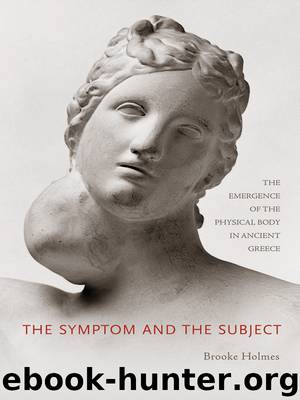The Symptom and the Subject by Holmes Brooke;

Author:Holmes, Brooke;
Language: eng
Format: epub
Publisher: Princeton University Press
Published: 2014-12-10T16:00:00+00:00
TAKING CARE
More than any other extant medical text, On Regimen (ca. 400 bce) attests the growing interest in the late fifth century in the care of the physical body.120 In the opening chapter, the author notes that many before him have written on the subject of human diaitē, a term that encompasses not only diet but also exercise, sexual habits, and a range of other behaviors.121 It is likely that he is referring to a recent—perhaps even within the past twenty years—spate of work. Most ancient writers, with the notable exception of the author of On Ancient Medicine, see regimen as a relatively late arrival to the medical tradition, and modern scholars have generally concurred.122 The later date fits well with what we see in On Regimen, which extends the causal theories and techniques of intervention familiar from other medical writings into the patient’s daily life.123 The author’s approach is driven, above all, by the need to exercise foresight to head off the symptom before it erupts.124 The treatise’s orientation suggests a reciprocal strengthening of anxieties about the physical body and public confidence in the power of medicine to manage it.
The preemptive strategy of regimen targets potential triggers of disease. In the case of environmental factors, which lie outside his control, the physician aims to remake the person’s nature to withstand their assault. He creates regimens capable of “warding off” seasonal changes as one might ward off the gods’ anger.125 If a cold and moist constitution is at risk in winter and spring, for example, regimen can supply warmth and dryness. Exercise molds the flesh so that the winds cannot.126 The language of making and molding here is not trivial. In On Regimen, the author dwells at length on similarities between crafts like metallurgy and carpentry and the arts of fashioning the physical body, which include both medicine and gymnastic training.127 By educating the layperson about the causes of disease, the physician also “remakes” him, preventing him from becoming another mindless force acting on his nature.
Crucial to the layperson’s role in health is what the author calls pre-sufferings. In the introduction, we saw how Plutarch uses these pre-sufferings to counter Hesiod’s “silent” diseases. In On Regimen, the author claims them as his own discovery:128
ἐμοὶ δὲ ταῦτα ἐξεύρηται, καὶ πρὸ τοῦ κάμνειν τὸν ἄνθρωπον ἀπὸ τῆς ὑπερβολῆς, ἐφ᾽ ὁπότερον ἂν γένηται, προδιάγνωσις. οὐ γὰρ εὐθέως αἱ νοῦσοι τοῖσιν ἀνθρώποισιν ἐπιγίνονται, ἀλλὰ κατὰ μικρὸν συλλεγόμεναι ἀθρόως ἐκφαίνονται. πρὶν οὖν κρατεῖσθαι ἐν τῷ ἀνθρώπῳ τὸ ὑγιὲς ὑπὸ τοῦ νοσεροῦ, ἃ πάσχουσιν ἐξεύρηταί μοι, καὶ ὅπως χρὴ ταῦτα καθιστάναι ἐς τὴν ὑγιείην. (Vict. I 2, Li 6.472 = 124,28–126,3 Joly-Byl)
These things have been discovered by me, and also, before a person suffers from surfeit, a “pre-diagnosis” on the basis of what sort it is. For diseases do not come upon people all at once; rather, gathering themselves together gradually, they appear with a sudden spring. So I have discovered what a person suffers before what is healthy in him is mastered by what is diseased, and how one ought to restore these things to health.
Download
This site does not store any files on its server. We only index and link to content provided by other sites. Please contact the content providers to delete copyright contents if any and email us, we'll remove relevant links or contents immediately.
| Africa | Americas |
| Arctic & Antarctica | Asia |
| Australia & Oceania | Europe |
| Middle East | Russia |
| United States | World |
| Ancient Civilizations | Military |
| Historical Study & Educational Resources |
The Daily Stoic by Holiday Ryan & Hanselman Stephen(3109)
The Fate of Rome: Climate, Disease, and the End of an Empire (The Princeton History of the Ancient World) by Kyle Harper(2870)
People of the Earth: An Introduction to World Prehistory by Dr. Brian Fagan & Nadia Durrani(2619)
Ancient Worlds by Michael Scott(2492)
Babylon's Ark by Lawrence Anthony(2430)
Foreign Devils on the Silk Road: The Search for the Lost Treasures of Central Asia by Peter Hopkirk(2387)
The Daily Stoic by Ryan Holiday & Stephen Hanselman(2343)
India's Ancient Past by R.S. Sharma(2295)
MOSES THE EGYPTIAN by Jan Assmann(2275)
The Complete Dead Sea Scrolls in English (7th Edition) (Penguin Classics) by Geza Vermes(2135)
Lost Technologies of Ancient Egypt by Christopher Dunn(2111)
The Earth Chronicles Handbook by Zecharia Sitchin(2101)
24 Hours in Ancient Rome by Philip Matyszak(1973)
Alexander the Great by Philip Freeman(1960)
Aztec by Gary Jennings(1877)
The Nine Waves of Creation by Carl Johan Calleman(1783)
Curse Tablets and Binding Spells from the Ancient World by Gager John G.;(1768)
Before Atlantis by Frank Joseph(1740)
Earthmare: The Lost Book of Wars by Cergat(1715)
